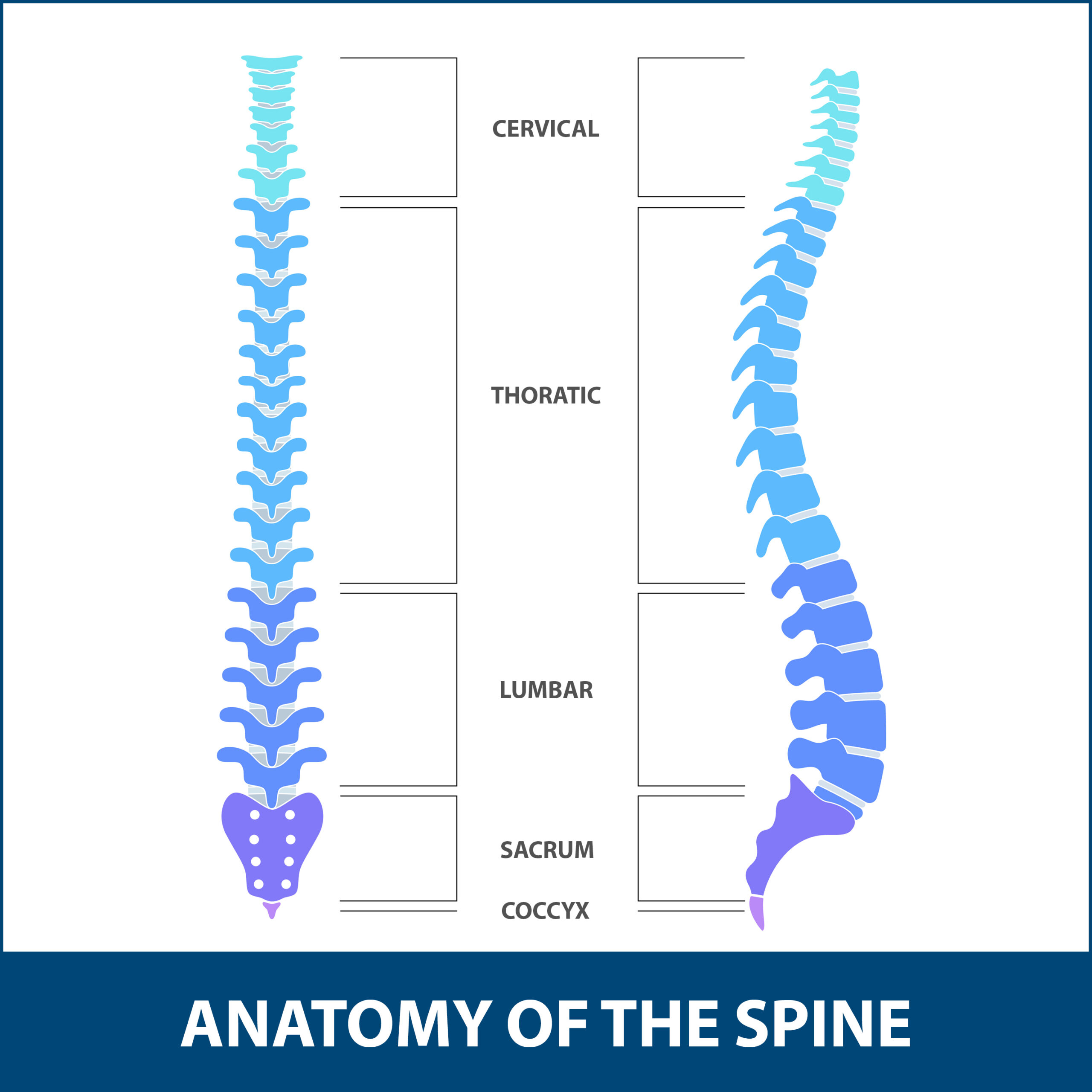Vertebroplasty – Bone Cement Injection
Overview
The backbone and spinal column are your body’s structural foundations. They help you stand up, move your limbs freely, and perform other vital functions.
The vertebra are a crucial part of your spine. The collection of these small bones makes up your backbone. When they are damaged or diseased, you could experience significant discomfort and potentially life-altering symptoms.
An injured vertebra can be treated through a surgical procedure called bone cement injection, also known as vertebroplasty.
Anatomy
The vertebrae are the small bones in your backbone.
People are born with 33 vertebrae, which shrinks to 24 in adulthood. This decrease happens because many vertebral bones in your lower back fuse together as your body grows.
The vertebrae are divided into several sections depending on their location. These vertebral regions include the lumbar, sacrum, coccyx, cervical, and thoracic.

Description
When these bones sustain an injury, disease, or gradually deteriorate, broken or chipped bone fragments can press against important nearby parts like nerves. In medical terminology, this is called compression.
Causes Of Vertebral-Induced Spinal Compression
One of the more common causes is a medical condition named osteoporosis. If you have this problem, your bones lose mass and density and grow brittle and weak. Over time, these factors could increase your risk of injuries like fractures.
Compression-causing vertebral breaks can result from cancerous and non-cancerous tumors, infections, or various immune system disorders. These fractures are called pathological breaks.
This issue may result from traumatic incidents. For example, most vertebral fractures in younger people are caused by trauma such as car accidents, falls from significant heights, excessive or forceful physical contact, or contact experienced during physical athletic competitions.
Symptoms
The most common spinal fracture symptom is back pain. This discomfort often appears suddenly and worsens when you stand, walk, or engage in any significant movements. You might also experience the following:
- Lessening pain when lying down.
- Discomfort spreading to your arms, legs, or neck.
- Numbness and tingling in your extremities.
- Increasingly limited mobility.
More severe or advanced cases may lead to height loss, visual abnormalities, posture issues, and possibly even paralysis.
Risk Factors
Though compression fractures can impact anyone, your risk is heightened if you are or have been:
- Female.
- Post-menopausal.
- Older than 65.
- Overweight or obese.
- Medications that can weaken bones like steroids or anti-depressant drugs.
- Affected by a previous compression fracture.

You are at higher risk of vertebral injury if you have unhealthy lifestyle habits like:
- Drinking alcohol excessively.
- Cigarette smoking.
- Not eating a diet containing bone-strengthening nutrients like calcium.
- Remaining physically inactive.
Diagnosing Compression Fractures and the Need for Bone Cement Injection
Your physician may diagnose a compression fracture based on a physical and visual examination.
Pinpointing the condition’s severity or your potential candidacy for bone cement injection will likely need an X-ray, MRI (Magnetic Resonance Imaging), CT (Computerized Tomography) scan, or bone density measuring machine.
Bone Cement Injection Basics
During the procedure, surgeons inject specialized cement into the damaged vertebra to fix and strengthen the broken spinal bones.
Are You a Good Candidate?
If less aggressive treatment methods do not ease pain or symptoms, your doctor might recommend this procedure. These non-surgical treatments may include:
- Rest.
- Movement-restricting devices like back braces.
- Physical therapy.
Bone cement injection is recommended if you are dealing with significant mobility problems or if the fracture has resulted in severe or life-threatening complications.
Preparation
You will not be permitted to eat or drink anything in the least six hours before your scheduled surgery. If your operation is in the morning, you may be asked to fast the night before.
You should inform your surgeon of any medications you take before the procedure. Certain drugs could increase your risk of potentially serious complications like infection or bleeding.
The Process
The procedure is usually performed with you under sedation with full general anesthesia. Then, using an X-Ray as a guide, surgeons insert a needle into your spine until reaching the damaged backbone. Once the vertebra is identified, the needle injects the cement into the cracked area until the opening is completely sealed.
Recovery
If the procedure does not have complications, you may be able to return home later that day. It is crucial to check your vital signs to ensure you are stable before you leave. You will also be required to attend follow-up examinations where your doctor will track the healing progression.
Intended Benefits
The procedure is usually well-tolerated, and most patients only experience minor and short-lived side effects. Most bone cement injection patients experience immediate pain relief and enjoy better mobility.
Next Steps
Please contact us if you have been diagnosed with a vertebral compression fracture or are experiencing the symptoms. Contact your Florida Orthopaedic Institute physician today to learn more about bone cement injections.
Areas of Focus
- Spine
- Anterior Cervical Corpectomy & Discectomy
- Artificial Disk Replacement (ADR)
- Bone Cement Injection
- Degenerative Disk Disease
- Diffuse Idiopathic Skeletal Hyperostosis (DISH)
- Discectomy
- Discitis Treatment & Information
- Epidural Injections for Spinal Pain
- Foraminotomy
- Interlaminar Implants
- Interlaminar Lumbar Instrumental Fusion: ILIF
- Kyphoplasty (Balloon Vertebroplasty)
- Kyphosis
- Laminectomy: Decompression Surgery
- Lumbar Epidural Steroid Injection
- Lumbar Interbody Fusion (IBF)
- Minimally Invasive Spine Surgery
- Outpatient Spine Surgery
- Pinched Nerve
- Piriformis Syndrome
- Sacroiliac Joint Pain
- Sciatica
- Scoliosis
- Spinal Fusion
- Spondylolisthesis and Spondylolysis
- Vertebroplasty
- Whiplash and Whiplash Associated Disorder (WAD)
The following Florida Orthopaedic Institute physicians specialize in Bone Cement Injection:
Specialties
- AC Joint Injuries
- Achilles Tendinitis - Achilles Insertional Calcific Tendinopathy (ACIT)
- Achilles Tendon Rupture
- Achilles Tendonitis
- ACL Injuries
- Ankle Fracture Surgery
- Ankle Fractures (Broken Ankle)
- Ankle Fusion Surgery
- Anterior Cervical Corpectomy & Discectomy
- Arthroscopic Articular Cartilage Repair
- Arthroscopic Chondroplasty
- Arthroscopic Debridement of the Elbow
- Arthroscopy Of the Ankle
- Articular Cartilage Restoration
- Artificial Disk Replacement (ADR)
- Aspiration of the Olecranon Bursa - Fluid In Elbow
- Atraumatic Shoulder Instability
- Avascular Necrosis (Osteonecrosis)
- Bankart Repair
- Basal Joint Surgery
- Bicep Tendon Tear
- Bicep Tenodesis
- Bone Cement Injection
- Bone Growth Stimulation
- Bone Health Clinic
- Broken Collarbone
- Bunions
- Bursitis of the Shoulder (Subacromial Bursitis)
- Calcific Tendinitis of the Shoulder
- Carpal Tunnel Syndrome
- Charcot Joint
- Chiropractic
- Clavicle Fractures
- Colles’ Fractures (Broken Wrist)
- Common Foot Fractures in Athletes
- Community Outreach
- Cubital Tunnel Syndrome
- De Quervain's Tenosynovitis
- Deep Thigh Bruising
- Degenerative Disk Disease
- Diffuse Idiopathic Skeletal Hyperostosis (DISH)
- Discectomy
- Discitis Treatment & Information
- Dislocated Shoulder
- Dupuytren’s Disease
- Elbow
- Elbow Bursitis
- Elbow Injuries & Inner Elbow Pain in Throwing Athletes
- Epidural Injections for Spinal Pain
- Finger Dislocation
- Flexor Tendonitis
- Foot Stress Fractures
- Foot, Ankle & Lower Leg
- Foraminotomy
- Fractured Fingers
- Fractures Of The Shoulder Blade (Scapula)
- Fractures Of The Tibial Spine
- Functional Nerve Transfers of The Hand
- Ganglion Cysts
- General Orthopedics
- Glenoid Labrum Tear
- Golfer's Elbow
- Groin Strains and Pulls
- Growth Plate Injuries Of The Elbow
- Hallux Rigidus Surgery - Cheilectomy
- Hammer Toe
- Hamstring Injuries
- Hand & Finger Replantation
- Hand & Wrist
- Hand Nerve Decompression
- Hand Skin Grafts
- Hand, Wrist, Elbow & Shoulder
- Heat Injury/Heat Prostration
- High Ankle Sprain (Syndesmosis Ligament Injury)
- Hip & Thigh
- Hip Arthroscopy
- Hip Dislocation
- Hip Flexor Strains
- Hip Fractures
- Hip Hemiarthroplasty
- Hip Impingement Labral Tears
- Hip Muscle Strains
- Hip Pointers and Trochanteric Bursitis
- Hyperextension Injury of the Elbow
- Iliopsoas Tenotomy
- Iliotibial Band Syndrome
- Impingement Syndrome of the Shoulder
- Interlaminar Implants
- Interlaminar Lumbar Instrumental Fusion: ILIF
- Interventional Pain Management
- Interventional Spine
- Intraarticular Calcaneal Fracture
- Joint Replacement
- Knee & Leg
- Kyphoplasty (Balloon Vertebroplasty)
- Kyphosis
- Labral Tears Of The Hip (Acetabular Labrum Tears)
- Laminectomy: Decompression Surgery
- Lateral Collateral Ligament (LCL) Injuries
- Lisfranc Injuries
- Little League Shoulder
- LITTLE LEAGUER'S ELBOW (MEDIAL APOPHYSITIS)
- Lumbar Epidural Steroid Injection
- Lumbar Interbody Fusion (IBF)
- MACI
- Mallet, Hammer & Claw Toes
- Medial Collateral Ligament Injuries
- Meniscus Tears
- Metatarsalgia
- Minimally Invasive Spine Surgery
- Morton’s Neuroma
- Muscle Spasms
- Muscle Strains of The Calf
- Nerve Pain
- Neuromas (Foot)
- Neurosurgery
- Olecranon Stress Fractures
- Orthopaedic Total Wellness
- Orthopaedic Trauma
- Orthopedic Physician Or A Podiatrist? Definition of a Podiatrist
- Osteoarthritis of the Hip
- Osteoporosis
- Outpatient Spine Surgery
- Partial Knee Replacement
- Patellar Fracture
- Pelvic Ring Fractures
- Peripheral Nerve Surgery (Hand) Revision
- Pinched Nerve
- Piriformis Syndrome
- Piriformis Syndrome
- Plantar Fasciitis
- Plastic Surgery
- Podiatry
- Primary Care Sports Medicine
- Quadriceps Tendon Tear
- Radial Tunnel Syndrome (Entrapment of the Radial Nerve)
- Revascularization of the Hand
- Reverse Total Shoulder Replacement
- Rheumatoid Arthritis (RA) of the Shoulder
- Rheumatoid Arthritis Of The Hand
- Robotics
- Rotator Cuff Tears
- Runner's Knee
- Sacroiliac Joint Pain
- Sciatica
- Scoliosis
- Senior Strong
- Shin Splints
- Shoulder
- Shoulder Arthritis
- Shoulder Arthroscopy
- Shoulder Injury: Pain In The Overhead Athlete
- Shoulder Replacement
- Shoulder Separations
- Shoulder Socket Fracture (Glenoid Fracture)
- SLAP Tears & Repairs
- Spinal Fusion
- Spine
- Spondylolisthesis and Spondylolysis
- Sports Foot Injuries
- Sports Hernias (Athletic Pubalgia)
- Sports Medicine
- Sports Wrist and Hand Injuries
- Sprained Ankle
- Sprained Wrist Symptoms and Treatment
- Subacromial Decompression
- Sudden (Acute) Finger, Hand & Wrist Injuries
- Targeted Muscle Reinnervation (TMR)
- Tendon Transfers of The Hand
- Tennis Elbow Treatment
- Thigh Fractures
- Thigh Muscle Strains
- Thumb Ulnar Collateral Ligament Injuries
- Total Ankle Replacement
- Total Hip Arthroplasty
- Total Hip Replacement - Anterior Approach
- Total Knee Replacement Surgery
- Trapezius Strain (Muscle Strain of The Upper Back)
- Traumatic Shoulder Instability
- Tricep Pain & Tendonitis
- Trigger Finger
- Turf Toe
- UCL (Ulnar Collateral Ligament) Injuries
- Ulnar Neuritis
- Valgus Extension Overload
- Vertebroplasty
- WALANT (Wide Awake Local Anesthesia No Tourniquet)
- Whiplash and Whiplash Associated Disorder (WAD)
- Wound Care
- Wrist Arthroscopy
- Wrist Fractures
- Wrist Tendonitis
Services
- Physical Medicine & Rehabilitation
- Physical Therapy
- Primary Care Sports Medicine
- PROMs (Patient-Reported Outcome Measures)
- Same-Day Orthopaedic Appointments Now Available
- Sports Medicine
- Sports-Related Concussion Treatment
- Telehealth Page
- Telemedicine
- Workers' Compensation
- Workers' Compensation Dispensary
- X-Ray
